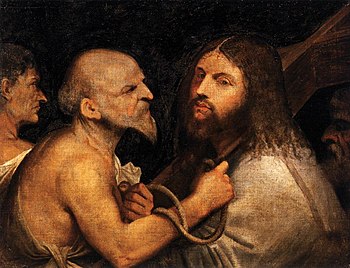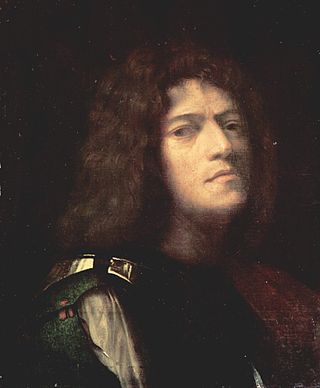
Giorgione was an Italian painter of the Venetian school during the High Renaissance, who died in his thirties. He is known for the elusive poetic quality of his work, though only about six surviving paintings are firmly attributed to him. The uncertainty surrounding the identity and meaning of his work has made Giorgione one of the most mysterious figures in European art.

Tiziano Vecelli or Vecellio, Latinized as Titianus, hence known in English as Titian, was an Italian (Venetian) Renaissance painter of Lombard origin, considered the most important member of the 16th-century Venetian school. He was born in Pieve di Cadore, near Belluno. During his lifetime he was often called da Cadore, 'from Cadore', taken from his native region.

Giovanni Bellini was an Italian Renaissance painter, probably the best known of the Bellini family of Venetian painters. He was raised in the household of Jacopo Bellini, formerly thought to have been his father, but now that familial generational relationship is questioned. An older brother, Gentile Bellini was more highly regarded than Giovanni during his lifetime, but the reverse is true today. His brother-in-law was Andrea Mantegna.
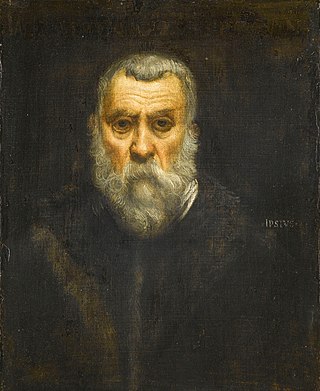
Jacopo Robusti, best known as Tintoretto, was an Italian painter identified with the Venetian school. His contemporaries both admired and criticized the speed with which he painted, and the unprecedented boldness of his brushwork. For his phenomenal energy in painting he was termed il Furioso. His work is characterised by his muscular figures, dramatic gestures and bold use of perspective, in the Mannerist style.
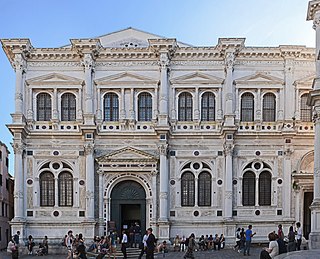
The Scuola Grande di San Rocco is a building in Venice, northern Italy. It is noted for its collection of paintings by Tintoretto and generally agreed to include some of his finest work.
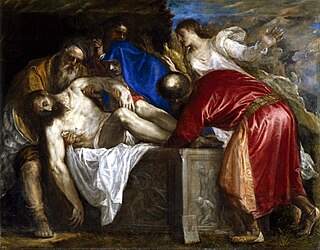
The Entombment is a 1559 oil-on-canvas painting by the Venetian painter Titian, commissioned by Philip II of Spain. It depicts the burial of Jesus in a stone sarcophagus, which is decorated with depictions of Cain and Abel and the binding of Isaac. The painting measures 137 cm × 175 cm and is now in the Museo del Prado in Madrid. Titian made several other paintings depicting the same subject, including a similar version of 1572 given as a gift to Antonio Pérez and now also in the Prado, and an earlier version of c.1520 made for the Duke of Mantua and now in the Louvre.

The Three Ages of Man or Reading a Song is a 1500-1501 painting by Giorgione, now displayed at the Galleria Palatina within the Palazzo Pitti in Florence.

Justice or Judith is a dry fresco by Titian, dating to around 1508 and now in the Galleria Giorgio Franchetti alla Ca' d'Oro, Venice.
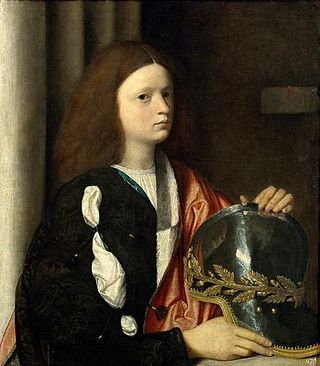
Portrait of Francesco Maria della Rovere is an oil-on-panel, later transferred to canvas, painting attributed to the Italian Renaissance artist Giorgione, executed c. 1502. It is now housed in the Kunsthistorisches Museum in Vienna. It depicts Francesco Maria I della Rovere, Duke of Urbino aged about 13.

Ixion is a 1632 oil painting, signed and dated by Jusepe de Ribera. It shows a scene from Classical mythology, of Ixion being tortured as the eternal punishment meted out by Zeus. It is one of a series of four paintings by Ribera of the four "Furies" or "Condemned" from Greek mythology. It is held by the Museo del Prado in Madrid, along with Ribera's painting of Tityos; the other two, of Sisyphus and Tantalus, are lost.
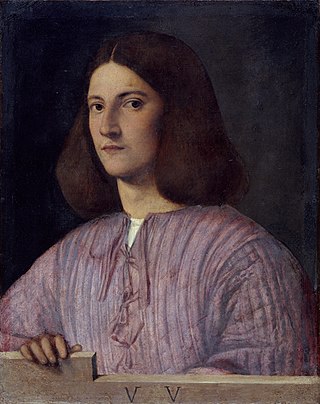
The Giustiniani Portrait or Portrait of a Young Man is a painting, usually dated to approximately 1503. The work is frequently, but not universally, attributed to Giorgione, and it is now in the Gemäldegalerie, Berlin.
Christ Carrying the Cross refers to Jesus's journey to his crucifixion.

Il Tramonto (The Sunset) is an oil on canvas landscape painting by Giorgione, created c. 1505–1508, now in the National Gallery, London, which bought it in 1961.

Detroit Trio, also titled The Appeal, is an oil on canvas painting attributed to Giorgione, Titian and Sebastiano del Piombo, executed c. 1500, now in the Detroit Institute of Arts.
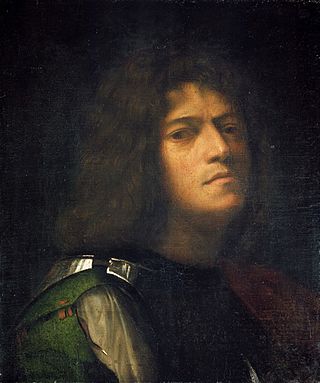
Self-Portrait as David is an oil-on-panel portrait executed c.1509–1510 by Giorgione, now in the Herzog Anton Ulrich Museum in Brunswick. It is not universally accepted as an autograph work but – if it is – it is thought to be the prototype for another Self-Portrait by the artist himself or an assistant.

The Pastoral Concert or Le Concert Champêtre is an oil painting of c. 1509 attributed to the Italian Renaissance master Titian. It was previously attributed to his fellow Venetian and contemporary Giorgione. It is located in the Musée du Louvre in Paris.

Giovanni Borgherini and His Tutor is a c. 1505 oil on canvas painting attributed to Giorgione and now in Washington's National Gallery of Art.
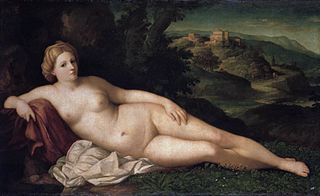
Nymph in a Landscape or Resting Venus is a c. 1518-1520 oil on canvas painting by Palma Vecchio, now in the Gemäldegalerie, Dresden. Its iconography derives from the Sleeping Venus by Giorgione, also now in Dresden.

The Old Woman is a 1506 oil on canvas painting by Giorgione, still in its original frame and now in the Gallerie dell'Accademia in Venice.
